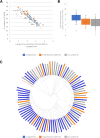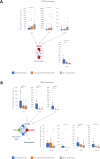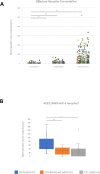Viral genomic, metagenomic and human transcriptomic characterization and prediction of the clinical forms of COVID-19
- PMID: 33780519
- PMCID: PMC8032121
- DOI: 10.1371/journal.ppat.1009416
Viral genomic, metagenomic and human transcriptomic characterization and prediction of the clinical forms of COVID-19
Abstract
COVID-19 is characterized by respiratory symptoms of various severities, ranging from mild upper respiratory signs to acute respiratory failure/acute respiratory distress syndrome associated with a high mortality rate. However, the pathophysiology of the disease is largely unknown. Shotgun metagenomics from nasopharyngeal swabs were used to characterize the genomic, metagenomic and transcriptomic features of patients from the first pandemic wave with various forms of COVID-19, including outpatients, patients hospitalized not requiring intensive care, and patients in the intensive care unit, to identify viral and/or host factors associated with the most severe forms of the disease. Neither the genetic characteristics of SARS-CoV-2, nor the detection of bacteria, viruses, fungi or parasites were associated with the severity of pulmonary disease. Severe pneumonia was associated with overexpression of cytokine transcripts activating the CXCR2 pathway, whereas patients with benign disease presented with a T helper "Th1-Th17" profile. The latter profile was associated with female gender and a lower mortality rate. Our findings indicate that the most severe cases of COVID-19 are characterized by the presence of overactive immune cells resulting in neutrophil pulmonary infiltration which, in turn, could enhance the inflammatory response and prolong tissue damage. These findings make CXCR2 antagonists, in particular IL-8 antagonists, promising candidates for the treatment of patients with severe COVID-19.
Conflict of interest statement
I have read the journal’s policy and the authors of this manuscript have the following competing interests: C.R. has served as an advisor, and/or speaker for Illumina, and Vela Diagnostics. S.F. has served as a speaker for Abbvie. F.C.-P. has served as an advisor for Abbvie. J.-D.L. reports research grants from Janssen, and has served as an advisor or speaker for Gilead, ViiV Health Care, Aelix Therapeutics. J.-L.C has served as an advisor for BMS, and HIFIBio. A.M.-D. reports research grants from Fischer Paykel, Baxter, Philips, Ferring, and GSK, and has served as an advisor or speaker for Air Liquide, Baxter, and Amomed, and as a speaker for Getingue, and Addmedica. P.-L.W has served as speaker for MSD. J.-M.P. has served as an advisor, and/or speaker for Abbvie, Gilead, GlaxoSmithKline, Merck, Regulus, and Siemens Healthcare. N.D., The remaining authors have no conflict of interest to disclose.
Figures





References
Publication types
MeSH terms
Substances
LinkOut - more resources
Full Text Sources
Other Literature Sources
Medical
Miscellaneous

